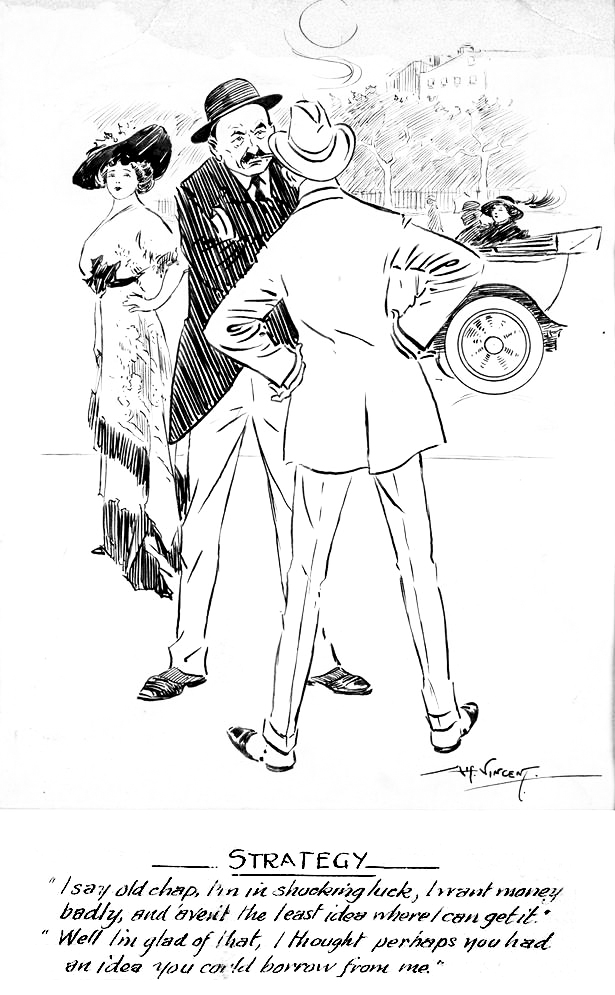Alfred Vincent on:
[Wikipedia]
[Google]
[Amazon]
 Alfred James Vincent (9 February 1874 – 6 December 1915) was an Australian cartoonist born in
Alfred James Vincent (9 February 1874 – 6 December 1915) was an Australian cartoonist born in
 Alfred James Vincent (9 February 1874 – 6 December 1915) was an Australian cartoonist born in
Alfred James Vincent (9 February 1874 – 6 December 1915) was an Australian cartoonist born in Launceston, Tasmania
Launceston () is a city in the north of Tasmania, Australia, at the confluence of the North Esk River, North Esk and South Esk River, South Esk rivers where they become the Tamar River, Tasmania, Tamar River (kanamaluka). As of 2021, the Launc ...
.
Early life
Vincent was born in Launceston, Tasmania, on 9 February 1874 to Frances (née Wilks) and William Thomas Vincent. At the age of seventeen, he presented "Skits: a memento from the Tasmanian Exhibition, Launceston, 1891-92."Cartoonist
Vincent's involvement with Melbourne ''Punch'' began in 1895 when he started contributing political cartoons. Notable works from this period include "Which is the Burning Question? ricket or Federation? dated 7 February 1895, "A Familiar Saying. 'After a Painting by Michael Angelo'" featured a policeman chasing a man with a painting under his arm (Melbourne ''Punch'' Almanac, 1895) and "Standing Room Only" dated 11 June 1896. In December 1896, at the age of 22, he assumed the main cartoon page of Melbourne Punch, succeeding Tom Carrington. Additionally, he created the anti-suffrage
Suffrage, political franchise, or simply franchise is the right to vote in public, political elections and referendums (although the term is sometimes used for any right to vote). In some languages, and occasionally in English, the right to v ...
cartoon titled "Will She Go to the Poll?" which depicted a woman on a bike pulling various items, including a pram and a kitchen stove. This cartoon was published in Melbourne ''Punch'' on 12 November 1896.
Alf Vincent contributed work to the ''Melbourne Punch
''Melbourne Punch'' (from 1900, simply titled ''Punch'') was an Australian illustrated magazine founded by Edgar Ray and Frederick Sinnett, and published from August 1855 to December 1925. The magazine was modelled closely on '' Punch'' of Lon ...
'' from 1895, in 1896 succeeding Tom Carrington as feature artist. After many years of submitting work to the ''Sydney Bulletin
''The Bulletin'' was an Australian weekly magazine based in Sydney and first published in 1880. It featured politics, business, poetry, fiction and humour, alongside cartoons and other illustrations.
''The Bulletin'' exerted significant influe ...
'', he joined their staff in 1898, as a replacement for Tom Durkin and remained there until 1915. He also contributed to ''The Bulletin''s sister publication, '' Lone Hand''.
His work may be mistaken for that of his idol Phil May (1864–1903), a fact that was noted by several critics, including A. G. Stephens
Alfred George Stephens (28 August 1865 – 15 April 1933), commonly referred to as A. G. Stephens, was an Australian writer and literary critic, notably for ''The Bulletin (Australian periodical), The Bulletin''. He was appointed to that positi ...
and Lionel Lindsay
Sir Lionel Arthur Lindsay (17 October 187422 May 1961) was an Australian artist, known for his paintings and etchings.
Early life
Lindsay was born in the Victoria (Australia), Victorian town of Creswick, Victoria, Creswick, into a creative f ...
.
He was a member of the Melbourne Savage Club
Melbourne Savage Club is a private Australian gentlemen's club founded in 1894 and named after the poet, Richard Savage. Bohemian in spirit, the club was to bring together literary men, and those immediately connected or sympathising with lit ...
from 1900 to 1915 and designed the club emblem. Along with Randolph Bedford
Randolph Bedford (born George Randolph Bedford 27 June 1868 – 7 July 1941) was an Australian poet, novelist, short story writer and Queensland state politician.
Early life
Bedford was born in Camperdown, Sydney, the son of Alfred Bedford, w ...
, Vincent was instrumental in the Savage Club changing their articles to accept artists as members without payment of a joining fee. This resulted in most of Melbourne's leading ale
Ale is a style of beer, brewed using a warm fermentation method. In medieval England, the term referred to a drink brewed without hops.
As with most beers, ale typically has a bittering agent to balance the malt and act as a preservative. Ale ...
artists joining the Club in the early Twentieth Century.
Death
After some months of ill health, aged 41 and a mental crisis he committed suicide at his home at Manly on the evening of 6 December 1915 by cutting his throat with a razor. His wife, Phyllis May (née Potter), whom he had married on 5 April 1913, at St James's Old Cathedral in Melbourne, and their daughter, outlived him. Phyllis May died in 1916.Collections
* Art Gallery of Western Australia, Perth * Castlemaine Art Museum * Art Gallery of New South Wales, Sydney * Ballarat Art Gallery, Ballarat * Melbourne Savage Club, Melbourne * National Gallery of Victoria, Melbourne * National Library of Australia, Canberra * National Gallery of Australia, Canberra * State Library of New South Wales, SydneySources
*McCullough, Alan, ''Encyclopedia of Australian Art'', Hutchinson of London, 1968, *Backhouse, Sue, ''Tasmanian Artists of the Twentieth Century'', Pandani Press, Hobart, 1988, * Williams, Graeme H., A Socio-Cultural Reading: the Melbourne Savage Club through its Collections, MA (thesis), Deakin, 2013References
{{DEFAULTSORT:Vincent, Alfred Australian editorial cartoonists 1874 births 1915 deaths People from Launceston, Tasmania 1915 suicides Suicides by sharp instrument in Australia Suicides in New South Wales Political commentators